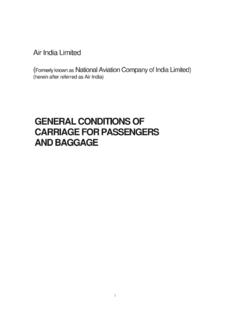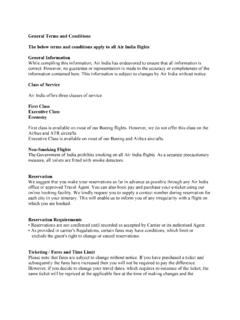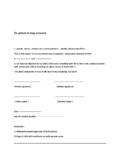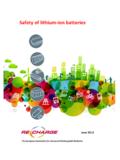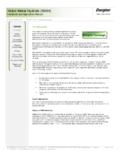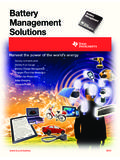Transcription of Small Vehicles Powered by Lithium Batteries …
1 Small Vehicles Powered by Lithium Batteries P a ss en g e r P ro v is ion s Background This notice is in response to questions raised by operators regarding the acceptability of Small Vehicles that are Powered by Lithium ion Batteries in passenger checked and/or carry- on baggage. There have been reports of these Small Vehicles being sold at airports in airside shops, as well as being available in many cities, particularly in Asia. Some examples of these Small Lithium battery- Powered Vehicles are: airwheel, solowheel, hoverboard, mini-segway, balance wheel. Discussion took place with a number of the members of the ICAO Dangerous Goods Panel as to how these devices should be treated for the purposes of the provisions of Dangerous Goods Carried by Passengers and Crew, DGR Subsection The agreed view is that these devices are not mobility aids , but instead be treated as portable electronic devices (PED) on the basis that the item subject to the Regulations is the Lithium ion battery that powers these devices.
2 The allowance for passengers or crew to have PED in their checked or carry-on baggage is determined by the size (Watt-hour rating) of the Lithium ion battery as follows: where the Lithium ion battery does not exceed 100 Wh passengers and crew may have these devices in either checked or carry-on baggage. Approval of the operator is not required;. where the Lithium ion battery exceeds 100 Wh but does not exceed 160 Wh passengers and crew may have these devices in either checked or carry-on baggage, but the approval of the operator is required; and where the Lithium ion battery exceeds 160 Wh the device is forbidden from being in either passenger or crew checked or carry-on baggage. IATA Cargo Page 1 02 December 2015. Recommendations In areas and cities where these devices are readily available operators should ensure that passenger handling staff and the ground service provider, where applicable, are made aware that these devices are subject to the restrictions applicable to PED as set out above.
3 Operators should consider developing posters, notices or other material with pictures or images of these Small Lithium battery- Powered Vehicles for display on their websites, at self-serve kiosks and check-in counters, specifically at airports serving cities where these devices are available, to alert passengers to the conditions applicable to their carriage in checked or carry-on baggage. At these airports, the operators may wish to bring this matter to the attention of the airport operator's committee so that a coordinated and consistent message is presented to passengers. The airport operator's committee may also wish to coordinate with the airport operator to ensure that on-airport retailers are made aware of the restrictions that apply to the carriage of these devices by passengers, and potentially the restriction on sale to passengers where the operator does not approve the carriage of PED with a Lithium ion battery that exceeds 100 Wh.
4 It is recommended that operators include the following in their operational manuals, or instructions to passenger service staff to address the passenger carriage of these Small Lithium battery- Powered Vehicles : Personnel, including those of ground service providers, must verify that: the devices are protected against accidental activation by either being in the original manufacturer's packaging or by taping over the on/off switch;. the Watt-hour rating of the Lithium ion battery in the device does not exceed 160 Wh. All Lithium ion Batteries are required to have the Watt-hour rating marked on the outside of the battery case. If passenger handling staff are unable to verify the Watt- hour rating by checking either the battery, or the user documentation, it is recommended that the passenger be advised that the device cannot be carried.
5 Note: The watt-hour rating is calculated by multiplying the voltage (V) by the ampere hours (Ah). Where the amperage is shown as milliampere hours (mAh) divide the mAh value by 1,000 to establish the Ah. If cabin crew identify that the device does not meet the operator's requirement during boarding, they should refer to the ground personnel for proper offloading. It is recommended that operators restrict these devices to carry-on baggage. However, PED as carry-on baggage are subject to specific operator restrictions on the size and weight of baggage permitted in the cabin. You can contact the IATA Dangerous Goods Support team if you have questions or concerns that may not have been addressed in this document at: IATA Cargo Page 2 02 December 2015.

